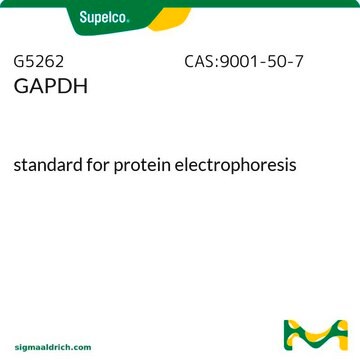G5537
Glyceraldehyde-3-phosphate Dehydrogenase from baker′s yeast (S. cerevisiae)
lyophilized powder, 70-140 units/mg protein
Synonym(s):
D-Glyceraldehyde 3-phosphate:NAD+ oxidoreductase (phosphorylating), GAPDH
Sign Into View Organizational & Contract Pricing
All Photos(1)
About This Item
Recommended Products
form
lyophilized powder
specific activity
70-140 units/mg protein
composition
Protein, 30-70% biuret
foreign activity
3-Phosphoglyceric phosphokinase ≤0.05%
storage temp.
−20°C
Biochem/physiol Actions
Glyceraldehyde-3-phosphate dehydrogenase catalyzes the conversion of glyceraldehyde-3-phosphate to 1,3-bisphosphoglycerate as part of glycolysis. It has also been shown to have roles in initiation of apoptosis, transcription activation and the shuttling of ER to Golgi vesicles<<<,New>>>.
Unit Definition
One unit will reduce 1.0 μmole of 3-phosphoglycerate to D-glyceraldehyde 3-phosphate per min in a coupled system with 3-phosphoglyceric phosphokinase at pH 7.6 at 25 °C.
Physical form
Lyophilized, sulfate-free powder stabilized with trehalose, citrate, and DTT. Useful for systems requiring low sulfate.
inhibitor
Product No.
Description
Pricing
Storage Class Code
13 - Non Combustible Solids
WGK
WGK 3
Flash Point(F)
Not applicable
Flash Point(C)
Not applicable
Personal Protective Equipment
dust mask type N95 (US), Eyeshields, Gloves
Certificates of Analysis (COA)
Search for Certificates of Analysis (COA) by entering the products Lot/Batch Number. Lot and Batch Numbers can be found on a product’s label following the words ‘Lot’ or ‘Batch’.
Already Own This Product?
Find documentation for the products that you have recently purchased in the Document Library.
Customers Also Viewed
A Tarze et al.
Oncogene, 26(18), 2606-2620 (2006-10-31)
Glyceraldehyde-3-phosphate dehydrogenase (GAPDH) is a pleiotropic enzyme that is overexpressed in apoptosis and in several human chronic pathologies. Here, we report that the protein accumulates in mitochondria during apoptosis, and induces the pro-apoptotic mitochondrial membrane permeabilization, a decisive event of
Lei Tong et al.
The Journal of biological chemistry, 284(17), 11256-11266 (2009-03-03)
Although the classical redox functions of co-enzyme NAD(+) are firmly established in metabolism, there are numerous enzymes that catalyze cleavage of NAD(+) to yield free ADP-ribose (ADPr) or related metabolites, whose functions remain largely unknown. Here we show that the
Michele Salemi et al.
Tumori, 98(3), 86e-88e (2012-07-25)
Head and neck squamous cell carcinoma (HNSCC) is one of the most common cancers in the world. Risk factors for this cancer include tobacco and alcohol use, ultraviolet light exposure, and viral infection. Parkinson's disease is one of the most
Soya S Sam et al.
Pathology, research and practice, 208(12), 705-707 (2012-10-13)
Isolation of DNA from formalin-fixed, paraffin-embedded (FFPE) tissue remains a laborious task for clinical laboratories and researchers who need to screen several samples for genetic variants. The objective of this study was to evaluate DNA isolation methods from FFPE tissues
Qiao Liu et al.
Acta crystallographica. Section F, Structural biology and crystallization communications, 68(Pt 8), 978-980 (2012-08-08)
Glyceraldehyde-3-phosphate dehydrogenase (GAPDH) is an important enzyme in the glycolytic pathway. In addition to its conventional metabolic role, GAPDH has been identified to possess diverse cellular functions. In this study, glyceraldehyde-3-phosphate dehydrogenase 3, the third isoform of GAPDH from Saccharomyces
Our team of scientists has experience in all areas of research including Life Science, Material Science, Chemical Synthesis, Chromatography, Analytical and many others.
Contact Technical Service











